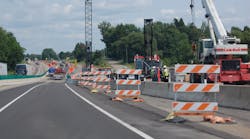More funding is being directed to state highways and bridges, yet “very little progress” has been made in improving their condition, according to the 21st Annual Highway Report released today by the nonpartisan Reason Foundation.
More specifically, states are “showing small progress in deficient bridges and pavement condition, but states struggle to make significant road improvements,” contend the authors of the 57-pg report, David T. Hartgen (Ph.D., P.E.), M. Gregory Fields and Baruch Feigenbaum.
Each year, the Reason Foundation researches each state’s highway conditions and their cost-effectiveness. This time out, Wyoming, Nebraska and South Dakota were ranked as “Best,” while Hawaii, Alaska and New Jersey were cited as “Worst.”
“Many of the easiest repairs and fixes to state highway and bridge systems have already been made and the rate of progress is slowing down,” said Hartgen, lead author of the Annual Highway Report since 1984.
“A widening gap also seems to be emerging between states that are still making improvements and a few states that are really falling behind on highway maintenance and repairs,” he continued.
The foundation found that spending on state-owned roads totaled $132 billion in 2012— up 6% from 2011. But it also discerned that spending varied wildly from state to state. South Carolina and West Virginia spent just $39,000 per mile of road in 2012, while New Jersey spent over $2 million per state-controlled mile. Rhode Island, Massachusetts, California and Florida were the next biggest spenders, outlaying more than $500,000 per state-controlled mile.
The authors contended that “high administrative costs in some states could be siphoning away money for road repairs.” The pointed out that Hawaii spent $90,000 on administrative costs for every mile of state road with Connecticut recording the next highest administrative costs at $77,000 per mile.
On the other hand, administration costs in Texas came in at less than $4,000 per mile and Kentucky spent less than $1,000 per mile on office costs, marking it as “best in the nation” in that regard.
Overall, from 2011 to 2012, pavement condition on urban Interstate highways showed a “very slight improvement,” with 4.97% of urban mileage determined to be in poor condition in 2012, down from 5.18% in 2011.
However, despite that year-to-year improvement, urban Interstate pavement condition was deemed to be the same as it was back in 2009.
Indeed, the report found over 10% of urban Interstate mileage in New York, New Jersey, Arkansas, Louisiana, California and Hawaii to be in poor condition. And those six states account for “nearly half of the nation’s potholed urban Interstate pavement mileage.”
On rural Interstates, pavement condition was found to be unchanged in 2012. But it was cited as 6% worse than in 2009. Almost half of the nation’s poor rural Interstate pavement is in just five states; Alaska, California, Colorado, Washington and Indiana.
Turning to rural arterial roads, the report found their pavement condition worsened from 2011 to 2012. New Jersey, Massachusetts, Rhode Island, Hawaii and Alaska were cited as having the “bumpiest conditions.”
As for bridges, the number deemed “deficient” continues to decline. Nonetheless, more than one-fifth of bridges (21.52%) are still regarded as either deficient or “functionally obsolete.”
California repaired over 2,800 bridges in 2012 and posted the lowest percentage (6%) of deficient bridges in the country. At the other end of the scale, over 50% of the bridges in Rhode Island were found to be deficient or functionally obsolete. That was the worst percentage in the nation.
There was a 1% drop from 2011 in the number of rural lanes deemed too narrow (less than 12 ft wide) for current safety standards.
After years of decreasing, the fatality rate on state-owned roads rose to 1.13 fatalities per 100 million vehicle miles travelled in 2012. That’s up from 1.10 in 2011.
While Massachusetts and Minnesota had the lowest fatality rates (.62 and .69, respectively), West Virginia (1.76), South Carolina (1.76) and Montana (1.72) had fatality rates “far above” the national average.
Texas, North Carolina and Virginia controlled the most state highway mileage in 2012. Hawaii, Rhode Island, Vermont and New Jersey had the smallest state highway systems.
Overall, Wyoming, Nebraska and South Dakota were deemed to have the most cost-effective state highway systems in 2012. Hawaii, Alaska and New Jersey came in with the least cost-effective systems.
The report also found that Kentucky, Wisconsin and Oklahoma scored the “greatest improvements” from 2011 to 2012, while Idaho, Louisiana, Virginia as well as other states dropped in the rankings.
Here is how the report ranked the states by the overall performance and cost-effectiveness of their highway systems:
- Wyoming
- Nebraska
- South Dakota
- South Carolina
- Kansas
- North Dakota
- New Mexico
- Mississippi
- Montana
- Kentucky
- Texas
- Missouri
- Georgia
- Ohio
- Wisconsin
- Maine
- Tennessee
- Iowa
- Arizona
- North Carolina
- Alabama
- Oklahoma
- New Hampshire
- Nevada
- Virginia
- Oregon
- Illinois
- Minnesota
- Utah
- Idaho
- Florida
- Michigan
- Colorado
- West Virginia
- Arkansas
- Indiana
- Delaware
- Vermont
- Maryland
- Louisiana
- Pennsylvania
- Washington
- New York
- Connecticut
- California
- Massachusetts
- Rhode Island
- New Jersey
- Alaska
- Hawaii
The Reason Foundation’s complete 21st Annual Highway Report is available online.
Also online is a breakdown of each state’s individual performance as well as previous editions of the annual report going back to 2006.
The Reason Foundation said that its Annual Highway Report measures the condition and cost-effectiveness of state-owned roads in 11 categories, including pavement condition on urban and rural Interstates, deficient bridges, unsafe narrow lanes, traffic fatalities, administrative costs and total spending on state roads.
The foundation also noted that the study’s rankings are based on data the states reported to the federal government for 2012-- except for its urban Interstate congestion rankings, which are based on the Texas A&M Transportation Institute’s congestion figures for the first time. Previous editions of the report had used congestion data based on volume-to-capacity (V/C) ratios published by the Federal Highway Administration. However, the FHWA has not published those tables since 2009.



